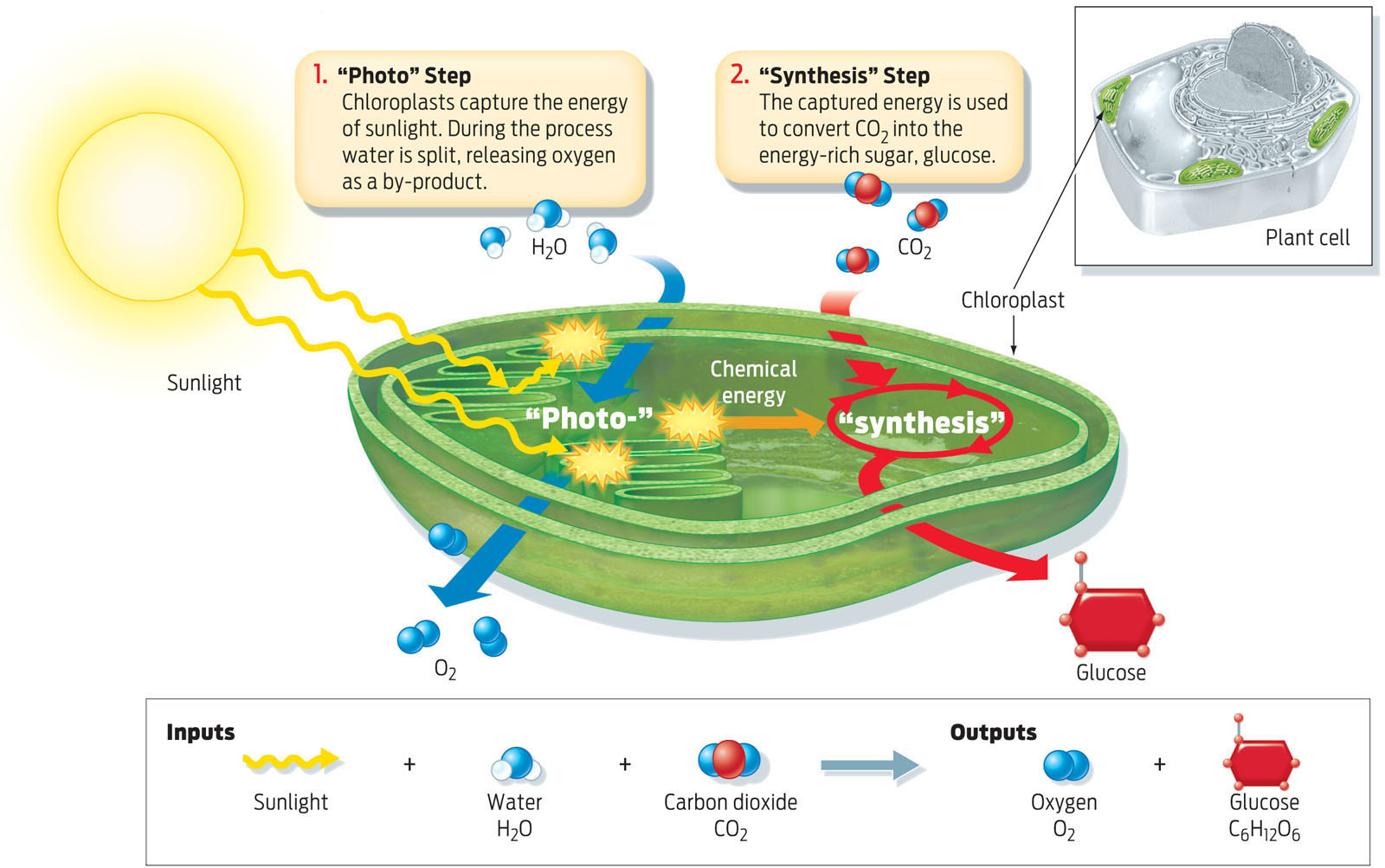CAPTURING ENERGY: PHOTOSYNTHESIS
How exactly do autotrophs use sunlight to create energy-rich molecules? The process of photosynthesis can be summarized in the following equation:
Sunlight + Water + Carbon dioxide ? Oxygen + Glucose
That is, plants and other photosynthesizers use the energy of sunlight to make the molecule glucose using carbon dioxide as a source of carbon. In the process, water molecules are split and oxygen is given off as a by-product.
Photosynthesis occurs in two steps: a “photo” step and a “synthesis” step. During the “photo” step, light energy is captured in chemical form. During the “synthesis” step, this chemical energy is used to generate glucose molecules using the carbon atoms of carbon dioxide. This synthesis phase does not directly require sunlight, but it does require the products of the “photo” reactions. The entire process occurs in an organelle called the chloroplast, which is present in the leaf cells of plants and the cells of photosynthetic algae (INFOGRAPHIC 5.7).
Photosynthesis is the process by which plants and other autotrophs use the energy of sunlight to make food. In plants, photosynthesis occurs in an organelle called the chloroplast, found in cells that make up the green parts of the plant. Photosynthesis has two main steps.

CHLOROPLAST The organelle in plant and algae cells where photosynthesis occurs.
The glucose made from photosynthesis is used by plants (or algae) in a variety of ways: it can be used for growth–to build new plant parts, like stems and fruit–or as an energy source to power cellular reactions.
104
While glucose is the major product of photosynthesis, other smaller sugars are produced during the “synthesis” reactions. Glucose and these other sugars provide the building materials for a variety of metabolic reactions in the cell—for example, the assembly of amino acids for protein synthesis and the synthesis of the oils that make up biofuels.
Like all photosynthesizers, algae take in carbon dioxide from the atmosphere and release oxygen. This is convenient for life on Earth, since many creatures—including humans—use this oxygen to breathe (see Chapter 6). Moreover, too much carbon dioxide in the atmosphere can be a bad thing. Carbon dioxide (CO2) is not just the gas that plants and algae take in during photosynthesis, it is also the gas that is released by burning fossil fuels. If you think about it, this makes perfect sense: fossil fuels such as coal, petroleum, and natural gas are the compressed remains of once-living photosynthetic organisms that have formed over millions of years; burning these fuels releases this stored carbon dioxide, sending it back into the atmosphere. Carbon dioxide is a greenhouse gas that is accumulating in the atmosphere and is in part responsible for increasing temperatures around the globe (see Chapter 23). By pulling carbon dioxide out of the atmosphere during photosynthesis, plants, algae, and other photosynthetic organisms help mitigate the effects of climate change.
As of 2012, there were more than 150 companies dedicated to making fuel from algae.
Another boon of using algae as a source of biofuel is that, because algae remove CO2 from the atmosphere as they grow, they release little net CO2 when they are burned—they are basically just returning to the atmosphere the same carbon they had removed. In addition, compared to traditional diesel, studies show that biodiesel releases less carbon monoxide and particulate matter. Algae-based biofuels aren’t only renewable, then, they are also more environmentally friendly when they are burned.
Algae’s need for carbon also presents a challenge for biofuel production: in order to grow large numbers of these microbes, biofuel companies need to provide their algae with more carbon dioxide than is readily available in the surrounding air. In other words, they have to have another source, which can be costly. Sears’s company, Solix, has set up its first biofuel production plant next to a beer manufacturer that produces carbon dioxide as a by-product of brewing (see the discussion of fermentation in Chapter 6). The company simply siphons off this carbon dioxide and feeds it to its algae, thus helping them grow.
Mass-producing algae, however, is not as simple as just putting microbes in a pond with some carbon dioxide, sitting back, and watching them grow. One problem is that algae need to be stirred frequently to incorporate carbon dioxide, a process that requires a lot of extra energy. Aurora Biofuels, an algae company based in Alameda, California, gets around this difficulty by using the carbon dioxide that is pumped into the ponds to drive circulation, rather than using a paddle wheel. This saves about four-fifths of the energy normally required. Another problem for algae growers is that in the summer, sunlight is so intense that it actually oversaturates the microbes, limiting their growth. Algae evolved to live below the surface of the ocean, where light is limited, so they don’t handle lots of sun very well.
To overcome this hurdle, in 2007 researchers at the University of California at Berkeley engineered algae with smaller antennae, the body parts algae use to absorb sunlight, similar to the way radio antennas receive electromagnetic signals. These smaller antennae help them avoid oversaturation and increase growth.
105
